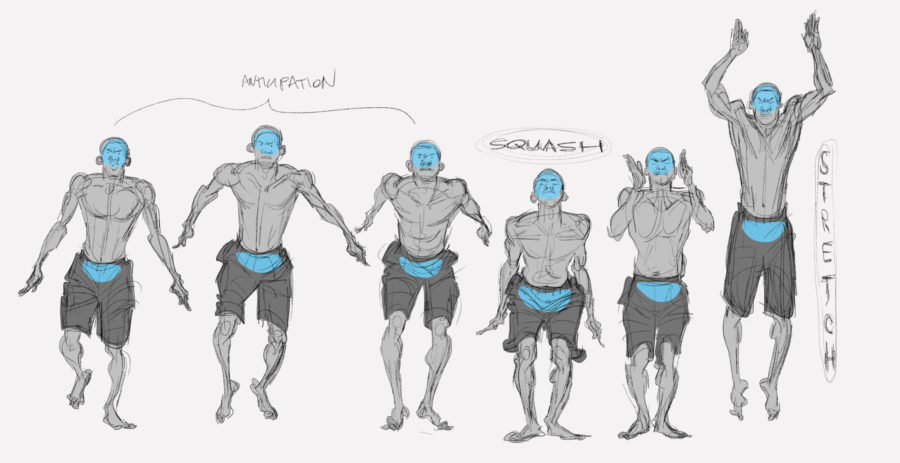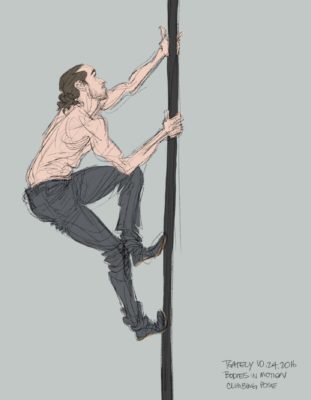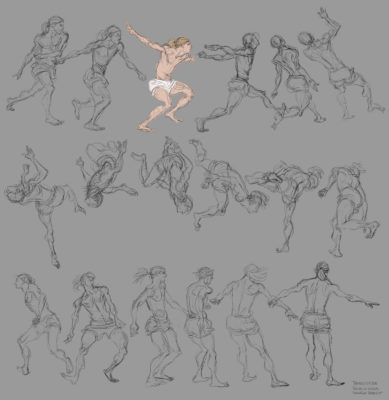It is our sincere pleasure to introduce Tom Gately. For the last ten years, Tom has worked as an artist, character designer, and animator at Pixar Animation Studio. Prior to that he was cranking out amazing drawings for Disney – animating some of our favorite Disney characters of the 90’s including Quasimodo from Hunchback of Notre Dame, and Hercules, from, uhh Hercules. Tom has been one the most prolific users of Bodies in Motion over the last few months and we would like to spare a few pixels to showcase his amazing work and also pick his brain about life, process and inspiration.
Q&A with Tom Gately
The Early Days, CalArts, Disney & Pixar
SCOTT: Hey Tom, amazing work in the Bodies in Motion gallery, we’re big fans. Your pages are masterclasses in gesture drawing. This kind of skill was surely honed over many years, please give us a bit of background on when you started drawing and how you developed your talent to this point?
TOM: Thanks. Honestly, I can’t remember a time when I didn’t draw. My Mom was an artist and she taught a local class at our house and I would sit in on those classes. I loved it. Caught the bug of drawing early, I suppose, and I’ve never stopped. I played a lot of sports growing up, as well, and I fused those two passions. I would draw sports figures very roughly, instinctively “feeling the pose”, and I would show my Mom and she’d say, “beautiful gesture drawing!” And I would be thinking, “Awesome. Now what the heck is a gesture drawing?!” I was always a huge fan of animation but I didn’t know that that could be a viable career. I thought I’d be a medical illustrator (‘cause that sounded cool) or something. I majored in Art in college and focused on representational art. My senior year I saw Little Mermaid and, quite literally, said to myself, “that’s what I want to do — be a Disney animator”. It just clicked. A few months later I was driving out to California (I grew up in New Jersey) to knock on Disney’s door and ask for a job.
SCOTT: Well, that all sounds risky, how did it work out (I think we know the answer)? And then a bit of professional background too, for those who don’t know you?
TOM: So… I got to Burbank and submitted a portfolio to Disney. This was 1991. I didn’t get accepted but they told me to apply to California Institute of the Arts (CalArts) and get some training. I drove up to CalArts and applied. Basically, a walk-in meeting/interview. I was accepted for the following year. I was thrilled. I drove back home and I spent the next 8 months drawing, going to local figure drawing classes, night classes and working 2 or 3 jobs. I started keeping sketchbooks at this point and would draw constantly — on the subways, commuting to NYC, at zoos, parks, etc. So by the time I started at CalArts I was ramped up and ready to go. The school was great. The teachers, students, curriculum were just perfect for me. Lots of connections to the animation industry, as well. Early in the winter semester, one of the teachers set up an interview for me at Disney to work on Lion King. The interview went well and, about a month later, I was working at Disney as a ‘Rough-Inbetweener’ on Lion King. This was the spring of 1993. It was surreal.
I worked with Andreas Dejas on Scar and with James Baxter on Rafiki. I was learning from two of the best animators in the world and I absolutely loved it (as intimidating as it was!) Actually, my first day on the job, I went to a figure drawing class at lunchtime, and who walks in? None other than Glen Keane! He was/is a huge inspiration of mine and I was star-struck. He made some of the most beautiful figure drawings that day — it was incredible. I also started taking a Gesture Class, taught by Disney legend Walt Stanchfield. He started talking about kinesthesia, rhythm, weight, energy! It was mesmerizing. I remember thinking, “this is absolutely the best class I’ve ever taken!” Over the years I became an animator and, more importantly, good friends with Walt. He featured my work in his famous handouts which gave me some exposure within the studio and outside of it, as well. Which I am/was so grateful for. I still hear Walt’s voice in my head when I’m drawing. His philosophy and approach to drawing (and life, for that matter) are the absolute best.

I worked at Disney for 10 or 11 years and worked with some amazing people and on some great films. I was pretty sad when it (hand-drawn animation) was all coming to an end. But — that lead me to Pixar! I started working on Cars as an animator in 2004 and was “in the weeds” learning computer animation that first year. The studio, the people, the energy there was awesome. I loved it. I started teaching a gesture class, a la Walt Stanchfield, while I was working on Ratatouille. I moved into the Art Department after that and was designing characters on Toy Story 3. During that time, I was lucky enough to be asked by Teddy Newton to be his animation supervisor on Day and Night, his Oscar-nominated short film. It was one of a kind, we did all of the character animation by hand, ‘the old-fashioned way’, with a clean-up crew and everything. Then we integrated that animation with CG animation for the inside/background animation. It was pretty cool to see that all come together.
So, things have come full circle. I’m teaching gesture classes, I’m doing draw-over work on films and shorts to help ‘push’ poses and I’m doing character designs on a variety of movies – and I’m loving it.

On Drawing
SCOTT: Epic story! I wasn’t expecting all that, thanks for sharing! With that deep experience, when you setup to draw a series of poses, say from a Motion from the BiM library, how do you start to analyse the sequence?
TOM: Well, I look at the sequence several times and analyze the action — I’m looking at the weight, the movement, the arcs and the shapes among other things. But, more importantly, I’m trying to feel that action in my own body – the kinesthesia. I try to feel where the squashes and stretches are, I try to find where the weight is being balanced and I try to find the character and personality. The more I can connect to the pose in that sense, the more success I’ll have in drawing the sequence.

SCOTT: In any single pose then, where do you start? Meaning how do you simplify all the complexity down into something you can begin to draw?
TOM: I feel like I have a strange method, but it works for me. I don’t start with the head. I typically start with the torso and hips, the biggest shapes, and I draw those in relation to where the weight is. Once I find the weight, I’m able to focus the energy around that, leaving the head to last, more often than not. I do that because, the head is the most important part, story-wise, and I’m able to frame the head (read: personality and story) exactly where I want it to be – essentially, it gives me a lot of options for staging. I know a lot of people are taught to start with the head so what I’m saying seems odd. But when I start with the head I feel like that limits me too much and there’s a huge tendency to straighten things up and suck the life out of the pose (which is, by far, the biggest problem people have with their poses). As far as simplifying goes, it plainly takes pencil-mileage and practice. Once you learn basic proportions, and what Glen Keane calls ‘working anatomy’ of the figure you’ll be in a good place. The more you draw the more you’re able to edit and minor details start dropping out and you get to the essence of the pose – which I think is the goal. But it just takes hard work, studying and lots of drawing – there aren’t really any shortcuts.
SCOTT: I like that, “Pencil Mileage,” this is the unseen element behind every successful drawing. Browsing through all the work you’ve done here, and on your Instagram feed, your figures all come across very gestural, does this mean were done quickly? What is the average time you spend on one of these figure sketches?
TOM: Part of the trick, and this applies to animation as well, is to make you’re drawings look spontaneous and effortless as possible. Most of my drawings range from 2-7min. I’ve worked hard at trying to keep the life in the pose even if I’m going longer on time. I know really quick sketches are extremely fun and exhilarating to do (and they should be done – a lot!) But I’ve gotten to the point where I like to analyze things more deeply and still try and pull off that elusive gesture.
SCOTT: Do you ever do longer drawing studies, 20+ minutes, getting into tone and that sort of detail?
TOM: I do. And it’s important to do them, even if they’re overworked and muddy. It’s for the knowledge and the recall so that when you’re in a gesture class the rote studying can be expressed in a more confident way. I wish I were better at drawing form, chiaroscuro, etc. I will be one day. But at the moment, I’m more committed to line drawing.
SCOTT: I know you are well versed in anatomy (full-disclosure, Tom was a diligent student on my Anatomy for Artists and Facial Anatomy courses) – how do you integrate this into your drawings?
TOM: Carefully. I don’t want a drawing to feel like medical illustration. I want the viewer to connect with the story, personality and kinesthetics of the pose. A drawing should ‘feel’ right. Hopefully the viewer isn’t walking away thinking, “that’s a great serratus anterior”. My goal is to have the anatomy support the gesture and have the specific anatomy fall into the background. That being said, I study anatomy all the time and it’s vitally important to solid drawing skills. Walt Stanchfield use to famously say, “draw verbs – not nouns”. It is so true. Draw what the anatomy is ‘doing’.
SCOTT: Do you have a daily drawing routine?
TOM: I’m a little maniacal I think. Not necessarily a routine but I try to draw 1-2 hours (on my own time) a day. I love drawing in the morning and start my day drawing gestures for about an hour. Subject matter changes, as does what I’m focusing on – but it’s important for me to just draw something. If I stop for a few days, I feel it.
SCOTT: What’s your preferred setup – digital or traditional (pencil/paper, wacom, ipad pro, surface pro, etc)?
TOM: I have a clipboard with a stack of color copy paper and draw on that with a soft Tombow 4B. I draw on my Cintiq at work using Photoshop and various other software programs. And recently, I’ve been using the Procreate app with my iPadPro. So, I mix it up. My preference will always be pencil and paper. (But the iPadPro and Apple pencil are pretty sweet.)

Inspiration, Books, and Advice
SCOTT: What advice would you give to people who want to develop their skill in gesture drawing?
TOM: Dive in! I’m just going to say it — “drawing is hard”. There. Now that you know that, you can move on. Immerse yourself in the works of the Great Masters – Degas, Michelangelo, Rembrandt, Toulouse-Lautec, etc. Put their drawings up, surround yourself with drawings or art work that inspires you. Then get to work. Betty Edwards’ book, Drawing on the Right Side of the Brain is a great place to start for beginners. Kimon Nicolaides’, The Natural Way to Draw is my favorite life drawing book and it has some great exercises. Draw things that interest you. Draw a lot. And please, try not to be your own hardest critic at first. And conversely, don’t be overconfident and feel like you’ve figured things out. If there’s one truism about drawing – it’s that there’s always more to learn.
SCOTT: Any other book recommendations – things that inspired you when you were learning?
TOM: Walt Stanchfield’s books are a necessity and they should be referenced often. I love the draughtsmen series by Borden Publishing Co. for the Great Masters are great (and there fairly cheap). I love New Yorker cartoons, especially, from a several decades ago. One artist, Charles Saxon, is terrific and he has a few compilation books that are just great. (To circle back about your earlier question about simplifying the figure, a huge help to me was studying these types of cartoons and their staging and simplicity.)
SCOTT: Since you seem up for it (and I am sure people are loving it), I’ll try to pry more knowledge out of you. Beyond these books and Mr Saxon, what contemporary (or otherwise) artists inspire you?
TOM: Almost everyone here at Pixar and in the animation industry in general. There are some amazing artists out there – Glen Keane, James Baxter, Tony Fucile, Daniela Strijleva, Deanna Marsigliese, the list goes on and on. Oh, and Ronald Searle, Carter Goodrich and Peter DeSeve… can’t forget them. Inspiration is everywhere.
On Bodies in Motion, Teaching and More…

SCOTT: Your Bodies in Motion studies are near-legendary, you’ve clearly enjoyed the site, what do you like most about Bodies in Motion?
TOM: It’s all great, honestly. Technically, the UI experience is fantastic. There are so many options built into the site. I love drawing from different views for one given action. It’s great for anatomy study, action analysis and gesture. The length of each sequences are perfect and gives you plenty to ‘chew on’ and study. It’s a great site.
SCOTT: Have you been using the timer on BiM at all?
TOM: It’s a very useful feature and I’ve monkeyed with it quite a bit. It helps you break routines and keeps you in the moment.
SCOTT: Is there anything in particular you like to see added to the BiM library?
TOM: I like the sequences with a beginning, middle and end. I love the parkour actions. Maybe some more action sets in the vein of Edward Muybridge.
SCOTT: I am sure people would love to learn from you. Do you teach anywhere? online?
TOM: I teach and give lectures here at Pixar and I’ve found that I really love teaching. I’m in the early stages of setting up a website to teach gesture drawing – for different experience levels, etc. I’m interested in teaching 2-3 day gesture seminars, I’m thinking of how Skype or FaceTime classes might work, essentially, I’m batting around a lot of different ideas now. If people are interested, I’d be all in.
SCOTT: You’re a bit of an internet hermit, is there anywhere that people can find out more about you and your work?
 TOM: Haha! Very true. I think I’m a bit of hermit, in general! I have piles and piles of drawings that I’m trying to organize and figure out how to share. I just started posting some of my work on Instagram
TOM: Haha! Very true. I think I’m a bit of hermit, in general! I have piles and piles of drawings that I’m trying to organize and figure out how to share. I just started posting some of my work on Instagram
Thanks for all of this Tom, very inspiring! I’m sure once people pick their jaws up off the ground, they are going to work through all those references and draw, draw, draw. For Bodies in Motion subscribers, you can find the complete collection of Tom’s Bodies in Motion studies (including links through to the original Motion reference) here:

